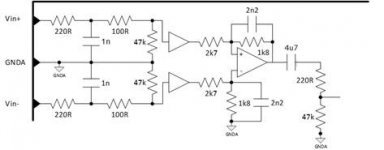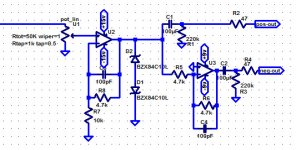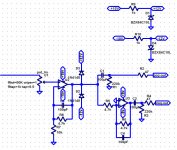Building a bass pre-amp for use with a class D power amp module. The documentation for the power amp says the balanced input cannot exceed 12 volts on the +/- inputs and my pre-amp works on 15 volt rails so I think I need to clamp the outputs to 12 volts, just to avoid any spikes. I want to push the power amp as much as possible without distortion.
The first attachment is the input section of the class D power amp from the documentation.
The second attachment is the output of my pre-amp with a clamp using paired 10v zener diodes to ground.
The third attachment is another clamp with silicon diodes going to 12 volt rails generated from the 15 volt rails using 10v zener diodes.
In both of these I have forgotten to add a resistor right before the clamping diodes. Probably something really small, under 1k.
Now which method is better, in terms of distortion, impedance or any other problems?
Is there a better way that doesn't involve many more components?
Can I lose the output caps or at least not use bi-polars?
Anything else wrong with this?
I'm using 10v zener diodes and not 12v zeners because in LTSpice simulations the flattened peaks were always a little above the specified voltage, because of the soft-knee characteristics of zener diodes.
The first attachment is the input section of the class D power amp from the documentation.
The second attachment is the output of my pre-amp with a clamp using paired 10v zener diodes to ground.
The third attachment is another clamp with silicon diodes going to 12 volt rails generated from the 15 volt rails using 10v zener diodes.
In both of these I have forgotten to add a resistor right before the clamping diodes. Probably something really small, under 1k.
Now which method is better, in terms of distortion, impedance or any other problems?
Is there a better way that doesn't involve many more components?
Can I lose the output caps or at least not use bi-polars?
Anything else wrong with this?
I'm using 10v zener diodes and not 12v zeners because in LTSpice simulations the flattened peaks were always a little above the specified voltage, because of the soft-knee characteristics of zener diodes.
Attachments
Last edited:
Is there a better way that doesn't involve many more components?
If you're going to have a series 1k at the op amp output anyway, then instead of the diodes
add a 4k to ground. This attenuates all signals including clipping, so a 15V output reduces to 12V.
Well yes I could do that but I want the highest possible level and just use the diode clamps
to remove any voltage spikes.
You still could use the 1k/4k attenuator, and increase the op amp gain by at least 2dB
to make up for the gain loss. Increasing R8 to 10k would do that.
Last edited:
Hi Guys
It is preferable to have the soft clipping at the preamp output to avoid the hard clipping at the PA output.
Most preamp outputs, the output buffers do not have a gain or if they do it is very low, like 3dB. There is a 3dB increase simply by having the balanced output so do you really need more than this? With a buffer and inverter the input would be where the clipping circuit is placed since then the output buffers would never clip.
Do you expect to run the PA at or near full output all the time? if so, then you should really be looking at your speaker setup and maybe also get into a band with "normal" players who play at Human Scale loudness levels.
Have fun
It is preferable to have the soft clipping at the preamp output to avoid the hard clipping at the PA output.
Most preamp outputs, the output buffers do not have a gain or if they do it is very low, like 3dB. There is a 3dB increase simply by having the balanced output so do you really need more than this? With a buffer and inverter the input would be where the clipping circuit is placed since then the output buffers would never clip.
Do you expect to run the PA at or near full output all the time? if so, then you should really be looking at your speaker setup and maybe also get into a band with "normal" players who play at Human Scale loudness levels.
Have fun
Hi Guys
It is preferable to have the soft clipping at the preamp output to avoid the hard clipping at the PA output.
Think that is what he is looking for.
So that would give us the desirable soft clipping from point #1?Most preamp outputs, the output buffers do not have a gain or if they do it is very low, like 3dB. There is a 3dB increase simply by having the balanced output so do you really need more than this? With a buffer and inverter the input would be where the clipping circuit is placed since then the output buffers would never clip.
He never listed the size of the power amp or the size of space being filled. You can get more efficient speaker systems but usually it comes at a cost, in price of drivers, weight of drivers and/or cabinet, size of cabinet. Sometimes the lower cost option to weight, size and expense is to increase the power.Do you expect to run the PA at or near full output all the time? if so, then you should really be looking at your speaker setup and maybe also get into a band with "normal" players who play at Human Scale loudness levels.
Have fun
I have a 30W amp that I would like to limit the signal to in a pleasing manner. Plan to use it with a lower efficient speaker that also comes with a lower mass magnet structure. While I can't put up with the racket that I did thirty years ago I also can not lug the same weight back and forth. Nothing to do with abnormal loudness levels. As far as the OP and his levels and needs goes, I'm not about to second guess him on his needs.
Hey, three Canucks, cool.
- Status
- This old topic is closed. If you want to reopen this topic, contact a moderator using the "Report Post" button.
- Home
- Live Sound
- Instruments and Amps
- Clamping pre-amp voltage output


